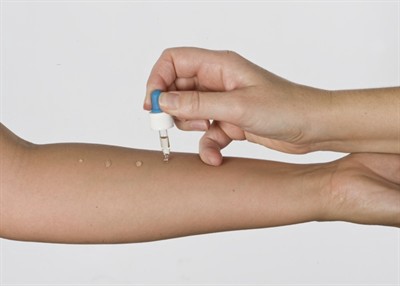
- HOME
- ABOUT
- FACE SCULPTING
- SKIN
- BODY
- FACE
- EQUIPMENT
- POST PROCEDURE
- CONTACT US
- IPAL ACADEMY
- HOME
- ABOUT
- FACE SCULPTING
- SKIN
- BODY
- FACE
- EQUIPMENT
- POST PROCEDURE
- CONTACT US
- IPAL ACADEMY
SKIN PRICK TEST VS PATCH TEST
admin
January 26, 2023

Overview
During allergy skin tests, your skin is exposed to substances suspected of causing an allergic reaction (allergens), and then it is monitored for signs of an allergic reaction.
Allergy tests, along with the use of your medical history, may be able to confirm whether a certain substance that you touch, inhale, or ingest is causing your symptoms.
Why is this being done?
Information from allergy tests may help your skin doctor create an allergy treatment plan that includes avoiding allergens, medications, or allergy shots (immunotherapy).
Allergy skin tests are widely used to help diagnose allergic conditions, including:
- Hay fever (allergic rhinitis)
- Allergic asthma
- Dermatitis (eczema)
- Food allergies
- Allergy to penicillin
- Allergy to bee venom
Skin tests are usually generally safe for adults and children of all ages, including infants. However, skin tests aren’t recommended for certain circumstances. Your doctor may advise you not to have a skin test done in the following cases:
You have ever had a severe allergic reaction. You may be hypersensitive to certain substances to the point that small amounts used in skin tests can lead to a life-threatening reaction (anaphylaxis or anaphylaxis).
You are taking medications that can affect the test results. This includes antihistamines, various antidepressants, and some heartburn medications. Your medical professional may determine that it is much better for you to continue taking these medications than to quit them briefly to prepare for a skin test.
You have certain skin diseases. If eczema or psoriasis affects large areas of skin on your arms and back – which are the usual test sites – there may not be enough clear, unaffected skin for an effective test. Other skin conditions – such as dermatographia – can cause unreliable test results.
Blood tests (in vitro immunoglobulin E tests) can be helpful for those who should not or cannot have skin tests. Blood tests are not used to detect a penicillin allergy.
In general, allergy skin tests are reliable for diagnosing allergies to airborne substances, such as pollen, pet dander, and dust mites. A skin test may be useful in diagnosing a food allergy. But because food allergies can be complex, they may need additional tests or procedures.
Request an appointment at the IPAL Skin Care Clinic
Risks
The most common side effect of a skin test is slightly swollen, red, itchy bumps (pustules). These blisters may be more noticeable during the test. However, some people may experience swelling, redness, and itching in an area of ?? skin a few hours after the test and stay that way for a few days.
In rare cases, allergy skin tests can cause a severe and immediate allergic reaction, so it’s important to have skin tests done in a clinic that has the right medications and devices available for emergencies.
How to prepare
Prior to recommending a skin test, your doctor will ask thorough inquiries regarding your case history, signs and symptoms, and your normal means of treating them. Your responses can assist your doctor to identify whether the allergic reaction runs in your family members as well as whether the allergic reaction is likely to create your signs. Your doctor may also conduct a physical examination to search for additional clues about why your signs and symptoms are developing.
Medicines can affect results
Before booking an appointment for a skin test, bring a list of all prescription and over-the-counter medications for your doctor to see. Some drugs can suppress the allergic reaction, which prevents the skin test from giving an accurate result. Other drugs may increase the risk of developing a severe allergic reaction during the test.
Because how quickly your body gets rid of medications varies by type, your doctor may ask you to stop taking some medications for up to 10 days. Medicines that can interfere with skin tests include:
Prescription antihistamines, such as hydroxyzine (Vistaril).
Over the counter antihistamines, such as loratadine (Claritin, Alavert), diphenhydramine (Benadryl), chlorpheniramine, cetirizine (Zyrtec Allergy), and also fexofenadine (Allegra). Tricyclic antidepressants, such as nortriptyline (Pamelor) and also desipramine (Norpramine). Particular heartburn medications, such as cimetidine (Tagamet) and ranitidine.
Omalizumab (Xolair) for asthma. This medication can confuse test results even after you’ve stopped using it for six months or longer. For comparison, most medications affect results from days to weeks.
ALSO READ: Causes of excessive sweating and its treatment
What you can expect
Skin tests are usually done in a doctor’s office. Usually, a nurse takes the test, while a doctor interprets the results. This type of test often takes about 20 to 40 minutes. Some tests reveal immediate allergic reactions that occur within minutes of exposure to an allergen (the allergen). Other tests reveal a delayed allergic reaction, which develops over several days.
Skin prick test
Often a positive reaction to an allergy test looks like a mosquito bite
The positive reaction to allergy test Open the popup dialog
The skin prick test, also known as a puncture or scratch test, checks for immediate allergic reactions to 50 different substances simultaneously.
Allergy skin tests aren’t painful. This type of test uses needles (lancets) that barely penetrate the surface of the skin. It will not cause you bleeding, just slight, momentary discomfort.
After cleaning the test site with alcohol, the nurse will make small marks on your skin and place a drop of an allergen extract (an allergen) next to each mark. He then uses a needle to prick the surface of the skin to introduce the extracts. With each allergen, a new lancing needle is used.
To see if the skin reacts normally, the surface of the skin is scratched and two additional materials are applied, namely:
Histamine. This substance causes a skin response in most people. If your skin is not showing a response to histamine, an allergy skin test may not detect an allergy even if you have one.
Glycerin or saline. These substances do not cause any reaction in most people. If you have shown a reaction to glycerin or saline, your skin may be sensitive. Test results should be interpreted with caution to avoid getting an incorrect allergy diagnosis.
About a quarter of an hour after the skin prick procedure, the nurse checks for signs of an allergic reaction. If you have an allergy to one of the substances tested, you will have a raised bump (whitish), red, itchy, and may resemble a mosquito bite. The nurse will then measure the size of the bump and record the results. Then he will clean the skin with alcohol to remove the marks.
Skin injection test
You may need a test in which a needle is used to inject a small amount of the allergen extract into the skin of your arm (intradermal test). After about 15 minutes, the injection site is examined for signs of an allergic reaction. Your doctor may recommend this test to check for an allergy to insect venom or penicillin.
Patch test
Patch tests are generally done to see if a specific substance is causing Atopic Dermatitis (contact dermatitis). These tests can detect delayed allergic reactions, which can take several days to appear.
Needles are not used for patch tests. Instead, allergens (allergens) are placed on a patch, which is then applied to the skin. During the test, your skin may be exposed to 20 to 30 extracts of substances that can cause contact dermatitis. Examples of these include latex, medicines, perfumes, preservatives, hair dyes, minerals, and resins.
Patches are placed on your arm or back for 48 hours. Throughout this time, you ought to avoid showering as well as tasks that cause heavy sweating. The patches are removed when you return to the doctor’s workplace
Results
ALSO READ:Dermatitis: the skin irritation
Before leaving the doctor’s office, you’ll know the results of a skin prick test or an intradermal test. The skin patch test may take several days or longer to obtain results.
A positive result on a skin test indicates that you may have an allergy to a specific substance. Usually, pimples that are larger in size indicate a greater degree of sensitivity. A negative result on the skin test indicates that you are not likely to have an allergy to a specific allergy (allergen).
Remember, however, that skin tests are not always accurate. Sometimes its results may indicate the presence of an allergy that is not present (false positive), or the test may not provoke any reactions when you are exposed to a substance to which you are allergic (false negative). This is because your response to the same test may vary with different circumstances. Or, your skin may show a positive reaction to a substance during a test when this does not happen in everyday life.
Your allergy treatment plan may include medications, immunotherapy, changes to your work or home environment, or dietary changes. Ask your doctor to explain anything you do not understand about a diagnosis or treatment. With the help of test results that identify allergens and a treatment plan that helps you control it, you will be able to reduce or eliminate allergy signs and symptoms.
Recent Posts



Have Any Question?
- +92-347-0008397
- [email protected]

